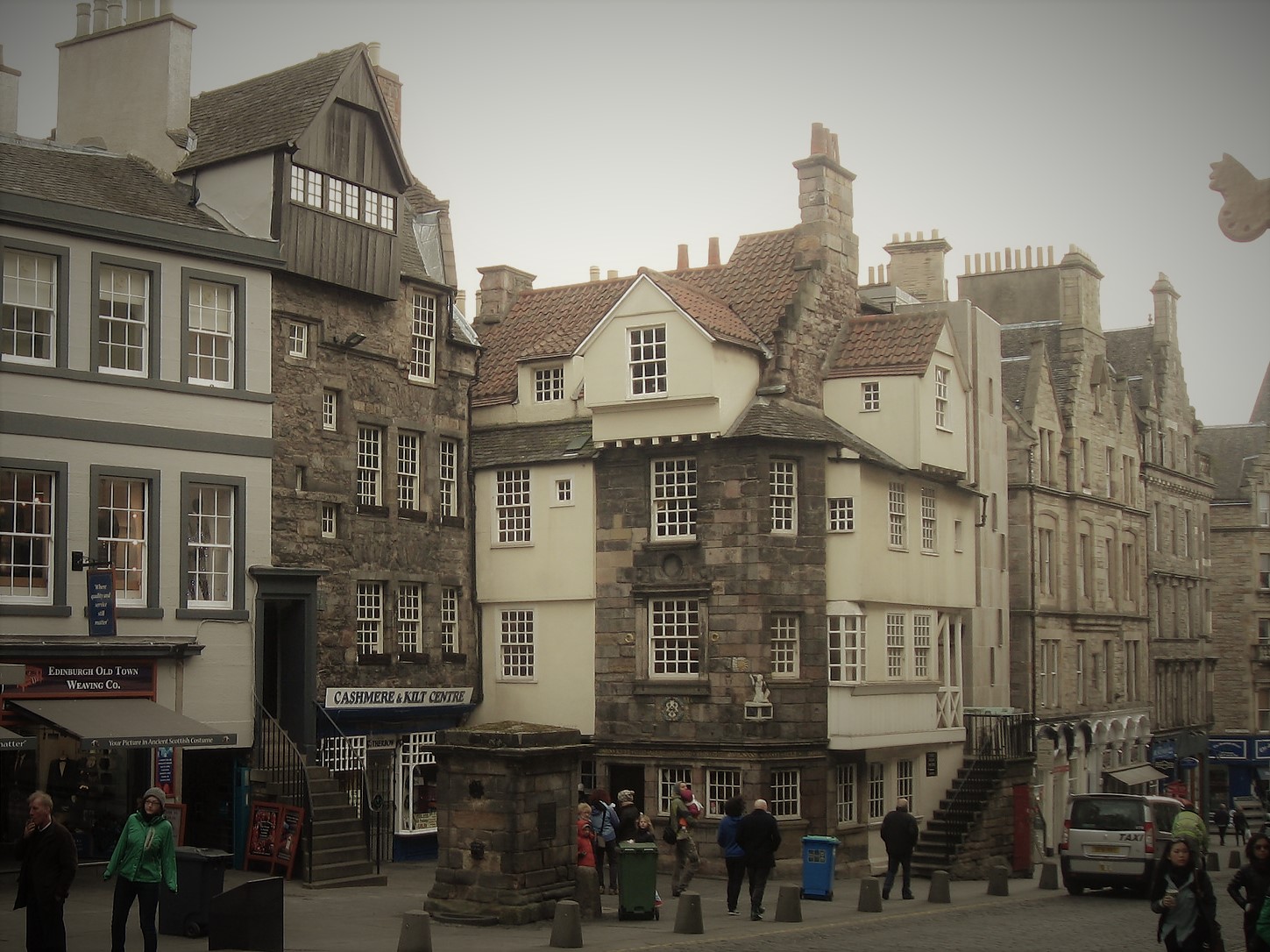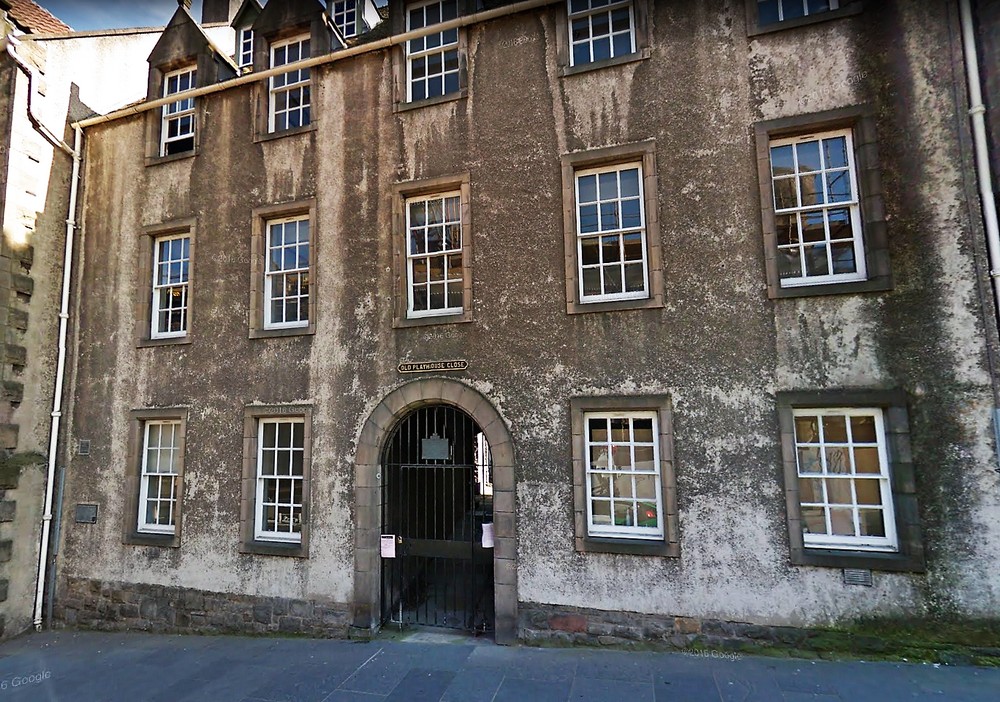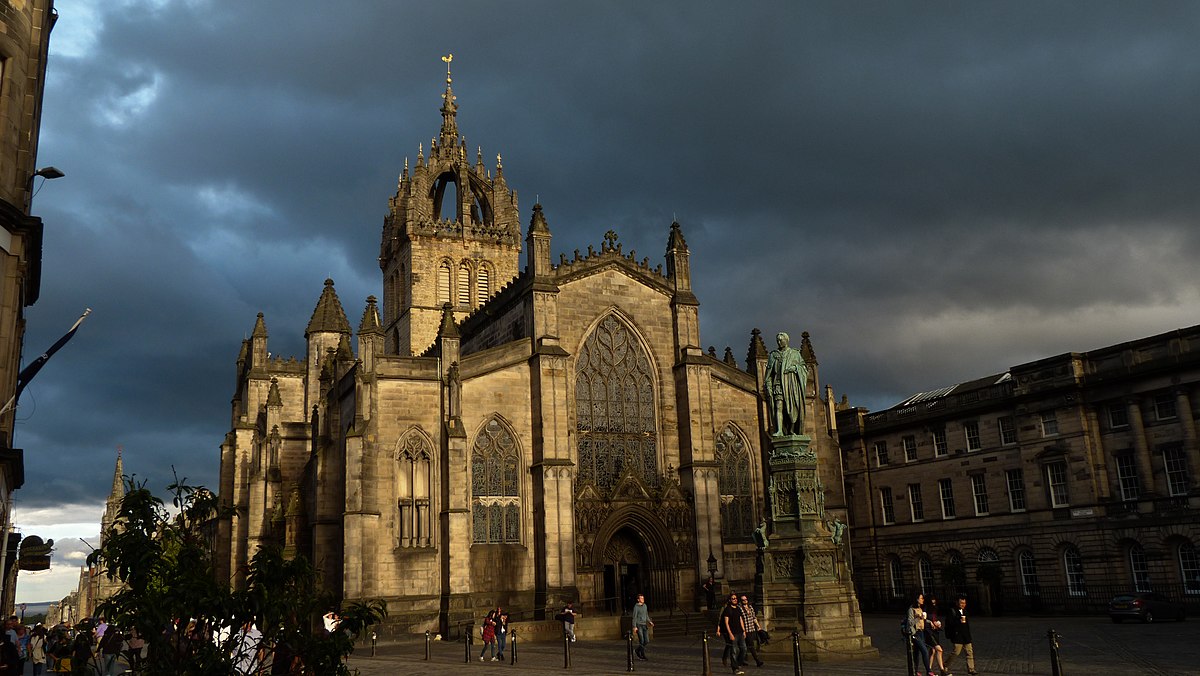
St. Giles' Cathedral at Sunset, Edinburgh
Photograph: Anne Sauvignon, Wikimedia (CC-BY-SA)
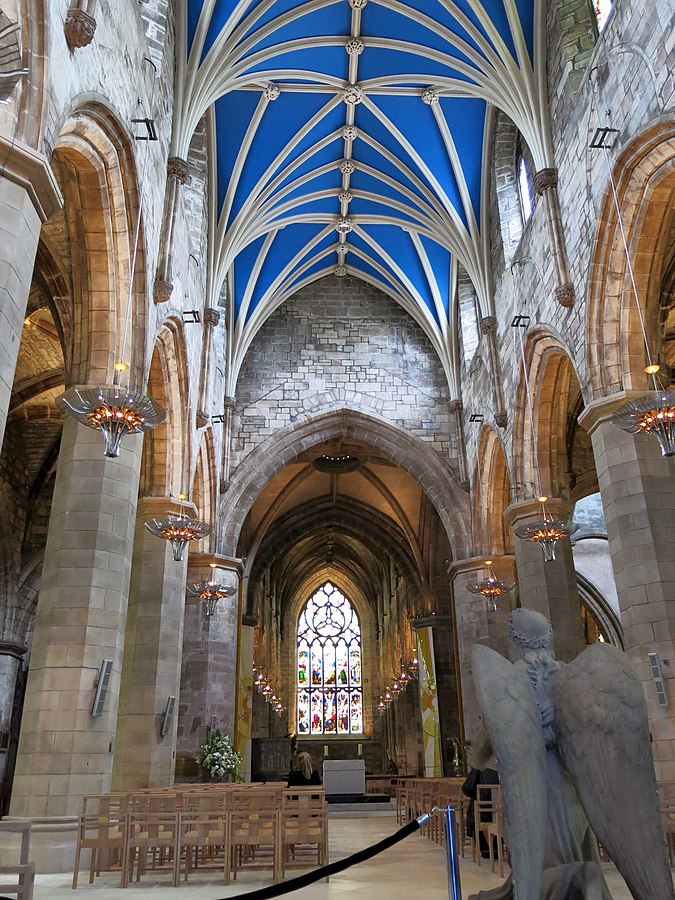
Interior of the St. Giles' Cahtedral, Edinburgh
Photograph: Enric, Wikimedia (CC-BY-SA)
St. Giles Cathedral
St. Giles Cathedral, the centre of worship of the church of Scotland, has a commanding position on the High Street of Edinburgh, as it has since its first incarnation in 1124. John Knox, the fiery and fearsome leader of the Scottish Calvinist Reformation of 1560, was minister of St. Giles and you will find a statue in his memory against the north-west wall of the Albany Aisle. It was created by the Scottish sculptor, Pittendrigh MacGillivray in 1906.
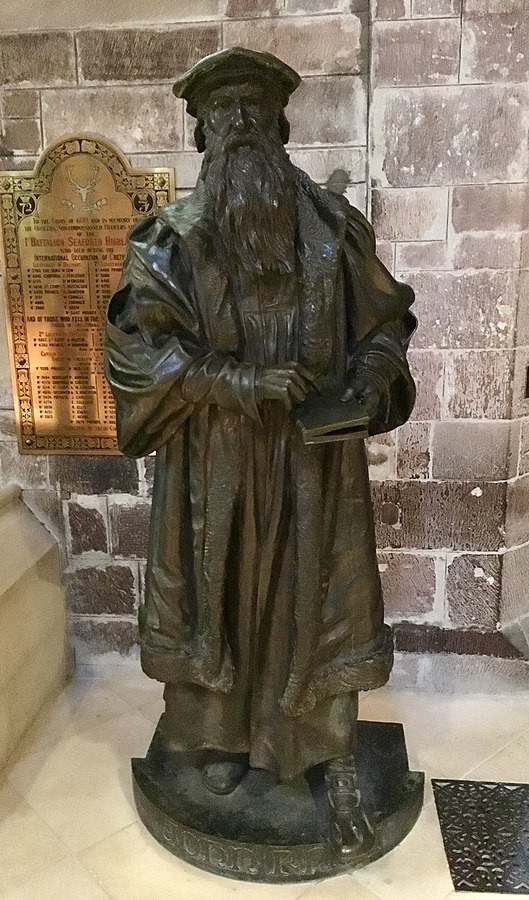
Pittendrigh MacGillivray, Statue of John Knox, 1906
Edinburgh, St. Giles' Cathedral
Photograph: Lorna Campbell, Wikimedia (CC-BY-SA)
The author of the remarkable diatribe The First Blast of the Trumpet Against the Monstrous Regiment of Women (1558) might seem an unlikely contributor to the progressive thinking of the Scottish Enlightenment two centuries later. However, the reformed church understood the need to educate the population in order that they could read the bible and John Knox championed this cause, despite the poverty of the country, writing as follows:
"Therefore, we judge it necessary that every several church have a schoolmaster appointed, such a one as is able, at least, to teach Grammar and the Latin tongue, if the town be of any reputation. If it be rural then must either the Reader or the Minister there appointed take care over the children and youth of the parish, to instruct them in their first rudiments, and especially in the Catechism. And further, we think it expedient that in every notable town there be erected a High School in which the Arts, at least Logic and Rhetoric, together with the tongues, shall be read by sufficient masters, for whom honest stipends must be appointed. Lastly, the great schools called Universities shall be replenished with those apt for learning."
The results were spectacular. By the time of the Enlightenment, Scotland had the highest standard of literacy of any European nation and had four universities, in contrast to only two in England. The ensuing flourishing of culture was perhaps an unintended outcome of Knox's actions, but his legacy is clear.
After visiting the cathedral walk round its right hand side on Parliament Square, viewing Parliament House on the right
The Select Society
A coincidence makes this location a hotspot of Scottish philosophy: between the Calvinist Reformation of John Knox around 1560 and the meetings of the Select Society two hundred years later. On the 12th. of November 1754, The Select Society held its first meeting in the Advocates' Library, located in Parliament House, Edinburgh on the left of St. Giles Cathedral. It was the brainchild of the portrait painter Allan Ramsay, the eldest son of the poet Allan Ramsay (see the first section). Together with David Hume, the philosopher and Adam Smith, moral and political philosopher they envisaged a club where:
"The intention of the gentlemen was, by practice to improve themselves in reasoning and eloquence, and by the freedom of debate, to discover the most effectual methods of promoting the good of the country" as published in the Scots Magazine in March 1755.
The original fifteen members were luminaries of the Scottish Enlightenment:
James Adam (1732 – 1794) architect and furniture designer, creator together with his brothers Robert and John of the neo-classical Adam style
John Adam (1721 – 1792) architect and son of William Adam
James Burnett, Lord Monboddo (1714 – 1799) judge and scholar of linguistic evolution, first to formulate the theory that all human origin was from a single region of the earth
George Drummond (1688–1766), Lord Provost of Edinburgh
Adam Ferguson (1723 – 1816), philosopher and historian, "the father of modern sociology", best known for his Essay on the History of Civil Society.
Francis Home (1719 – 1813) physician and first Professor of Materia Medica at The University of Edinburgh and originator of first attempts to vaccinate against measles
Henry Home, Lord Kames (1696 – 1782), judge and philosopher and one of the founder members of the Philosophical Society of Edinburgh
David Hume (1711 – 1776) philosopher and renowned sceptic
John Monro (1725 – 1789) advocate
Allan Ramsay (1713 – 1784) portrait artist of the Enlightenment
William Robertson (1721 – 1793) historian, minister in the Church of Scotland, and Principal of the University of Edinburgh
Adam Smith (1723 – 1790) economist and moral philosopher, author of The Wealth of Nations.
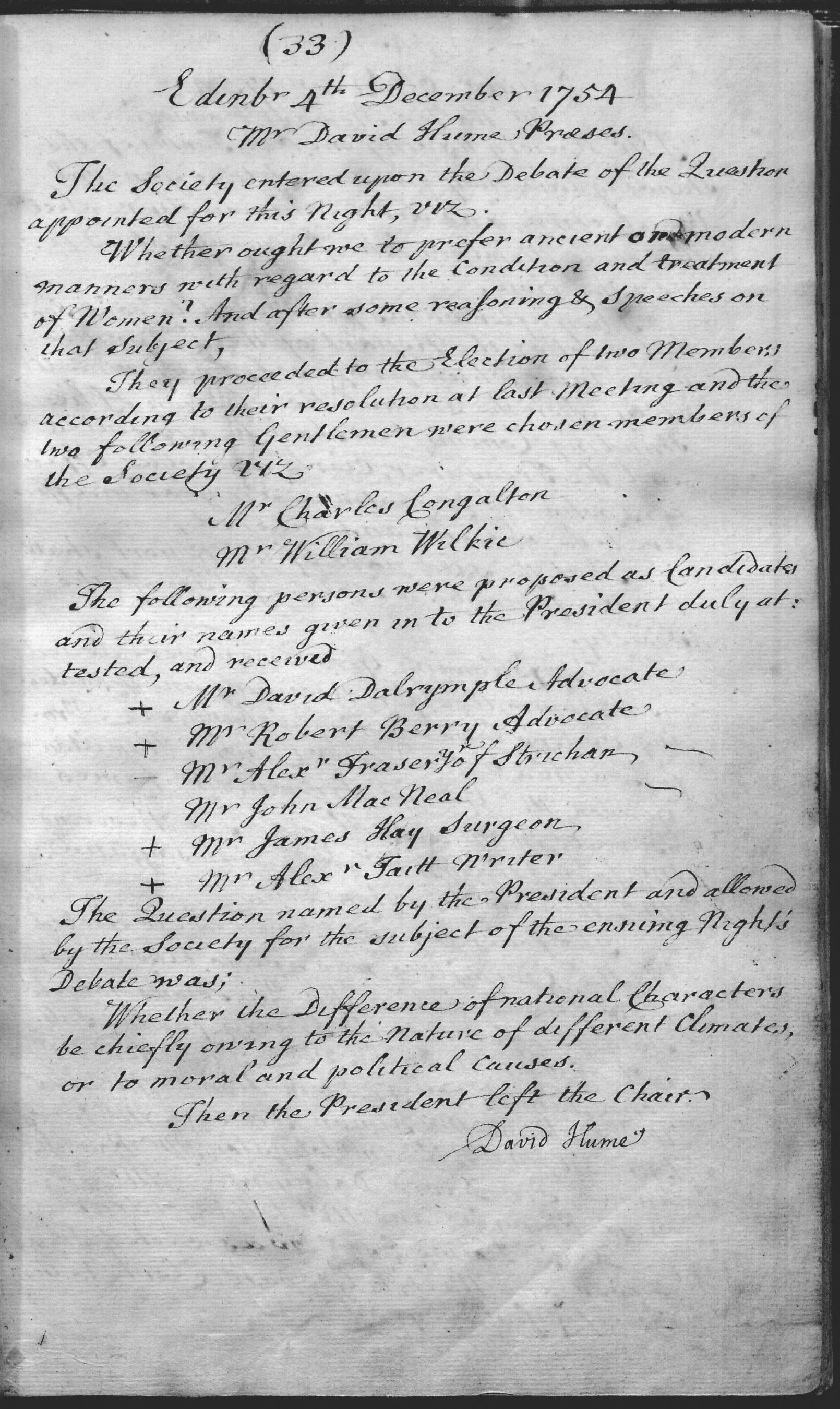
Minutes of the Meeting of the Select Society of December 4th. 1754, prepared by David Hume
(Under license from the Historic Environment Scotland)
The Society was indeed select. Membership was not dependent on rank, title or wealth, but rather on education and the ability to engage in interesting conversation. On a critical note, however, all members were men, which undoubtedly limited the scope of discussion.
Continue to the back of the cathedral where you will find the statue of Adam Smith.
At the back of St. Giles Cathedral, you will find a statue of Adam Smith. His first academic position was actually as Professor of Moral Philosophy at Glasgow University, but he spent much time in Edinburgh and died here in 1790. His collaboration with David Hume is exemplified by the deliberations of the Select Society (see section 4). His two most famous works, The Wealth of Nations and The Theory of Moral Sentiments have sometimes been considered to contradict each other, the so-called "Adam Smith Problem." Among his famous quotations, "It is not from the benevolence of the butcher, the brewer, or the baker that we expect our dinner, but from their regard to their own interest." might be said to reflect The Wealth of Nations while the following quotation from The Theory of Moral Sentiments proffers a different view:
"How selfish soever man may be supposed, there are evidently some principles in his nature, which interest him in the fortune of others, and render their happiness necessary to him, though he derives nothing from it except the pleasure of seeing it…. As we have no immediate experience of what other men feel, we can form no idea of the manner in which they are affected, but by conceiving what we ourselves should feel in the like situation."
In reality, the quotations are testament to the nuanced nature of Smith's philosophical thinking. Eklund and Hebert have offered a means of resolving the apparent contradiction between the Theory of Moral Sentiments and The Wealth of Nations, writing in A History of Economic Theory and Method: "In the former, sympathy is the moral faculty that holds self-interest in check, whereas in the latter, competition is the economic faculty that restrains self-interest."
The statue of Adam Smith created by Alexander Stoddart and unveiled on the 4th of July 2008 stands imperiously on the Royal Mile, aptly placed at the site of an old market place and across from the original Royal Exchange of Edinburgh (now Edinburgh City Chambers).

Alexander Stoddart, Statue of Adam Smith, 2008
Photograph: Roger Cornfoot, Wikimedia (CC-BY-SA)
